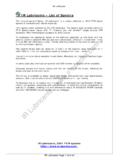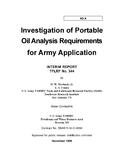Transcription of HYDROGEN PEROXIDE HANDLING & STORAGE
1 HYDROGEN PEROXIDEHANDLING & STORAGE table of contents1. Introduction3 2. Physico-chemical Physical Toxicological Chemical propertiesReactionsOxidantReductantPerox y compoundsAddition Decomposition propertiesEffect of pHEffect of lightEffect of heatHomogeneous decompositionHeterogeneous decompositionEffect of Effects of decompositionPressure build upHeat release and self-heatingSuperheated Spontaneous combustion of organic Explosive characteristics3. Transportation and packaging11 RegulationsMarking and labelling4. Storage12 Small containers and IBCsISO tanksBulk storageSiteTankFittingsPiping system ValvesPumpsMeasuring tanksPretreatmentDispensing from storage5.
2 Product handling17 Basic rulesGeneral precautionsDilutionTransfer into storage6. Construction materials for STORAGE 18and HANDLING Unsuitable materialsSuitable materialsAluminium and its alloysAustenitic stainless steelPlastic tanksOther non-metalsLubricantsPumpsValvesGaskets7. Personnel safety instructions22 Personnel protectionEquipmentFirst aid8. Some common types of incidents23 Emergency proceduresLeaksBulging packagesDecomposition and Other aspectsClosed valvesNon-vented valvesPumpingFire-fightingDisposal 9. Further information26hydrogen PEROXIDE -h a n d l i n ga n ds t o r a g eIntroductionAs part of Solvay s declared commitment to RESPONSIBLE CARE * ,S O LVAY INTEROX works ceaselessly at minimising the risks of its pro d u c t sto people and the environment.
3 These efforts include the provision of manyd i ff e rent types of information and advice on all aspects of operations. Nume-rous other activities include inspections, design, analyses and principle is to work in partnership with customers and others to achieveour mutual objective of safe and effective peroxygen manual presents information on the safety, HANDLING and STORAGE of com-mercial solutions of HYDROGEN PEROXIDE up to 70 % w/w . Other safety information available from SOLVAYINTEROX is listed on page 26of this manual.* RESPONSIBLE CARE is an internationalinitiative of the chemical industry aimed at thecontinuous improvement of its performance inthe areas of health, safety and the PEROXIDE has been produced by SOLVAYINTEROX for morethan forty years, and during this time much experience has been gained in the HANDLING , STORAGE and use of this important industrial the early days of its industrial production, the principal use of hydro g e nperoxide was as a bleaching agent, but in recent years many other applications have been found such as, for example.
4 In chemical synthesis,water treatment, soil remediation, environmental applications, surfacetreatment of metals, electronics and of the major advantages of HYDROGEN PEROXIDE over most other oxidising agents used in industry is that it is non-polluting by itself sinceits principal reaction by-product is purpose of this publication is to provide general information andadvice, which, if followed, will help the user to handle and store concen-trated HYDROGEN PEROXIDE solutions safely and without properties(For a more detailed account see SOLVAY INTEROX Data Manual on HydrogenPeroxide).
5 H y d rogen PEROXIDE is a clear, colourless, liquid miscible with water in any proportion. Its molecular weight is y d rogen PEROXIDE is marketed in the form of aqueous solutions and the follow-ing table shows the principal characteristics of some of addition to the Data Manual, SOLVAY INTEROX technical services are at thecomplete disposal of customers for further clarification of the propertiesConcentrations of 5 % W/W and above can cause irritation or burns, with theseverity increasing with of dilute H2O2in the eyes cause pain. With solutions of 6 % W/W anda b o v esevere and permanent damage may ingestion of H2O2can cause burning of the mouth, throat, oesophagusand stomach, and internal distension from evolved oxygen.
6 In some instances,ingestion of commercial strengths can be Physico-chemical propertiesH202contentg/100 at 20 Cg/100 ml ofgaseous oxygen (litre)given off per litreof solution at 20 C(0 C and 760 mmHg or 101,325 kPa)I/I103471100110130197246298 Active point point kPa(760 mm Hg at 0 C) at0 W/V% W/W Effect on the skin Effect on the eyesEffect of ingestionInhalation of H2O2vapours or mists is irritating to the respiratory tract. Theoccupational exposure limit (TLV) is ppm ( H2O2/m3air) for a normal8 hour/day and 40 hour/week working further information see the current SOLVAY INTEROX aid: (See page 22) propertiesHydrogen PEROXIDE reacts :- as an oxidant- as a reductant- to form other inorganic and organic peroxy compounds- to form addition compoundsExamples of such reactions propertiesA further type of reaction is its decomposition to water and oxygen representedas.
7 This can occur under various conditions which are identified alkaline solution, the rate of decomposition increases rapidly as the pH PEROXIDE and alkali must never beinadvertently of inhalationFirst AidReactionsOxidantReductantPeroxy compoundsAddition compoundEffect of pHLight can cause photochemical decomposition of HYDROGEN PEROXIDE . Theabsorption of radiation by HYDROGEN PEROXIDE solutions occurs over a widecontinuous spectrum. HYDROGEN PEROXIDE solutions should not therefore beexposed for long periods to light, especially direct unfiltered from self-heating as a result of decomposition, consideration must begiven to the effect of temperature rises caused by outside sources of heat.
8 For purely physico-chemical reasons, the rate of the decomposition reaction insolution (homogeneous) will increase 2 to 3 times for every 10 C increase in t e m p e r a t u re ,and the rate of the surface decomposition (heterogeneous) willincrease 1 to 2 times per 10 C. The effect of increased contamination from dissolution of the surface can of course make the situation HYDROGEN PEROXIDE from direct PEROXIDE as produced by SOLVAY INTEROX is very pure and thedecomposition rate to water and oxygen is normally very low. However, if thehydrogen PEROXIDE becomes contaminated with salts of metals such asiron, copper, chromium, vanadium, tungsten, molybdenum, silver and metalsfrom the platinum group, then fast decomposition to water and oxygen mayfollow.
9 This is known as homogeneous decomposition. The most activedecomposition catalysts are those giving multivalent ions. Fast decompositioncan often be caused by extremely low levels of contaminants, for example afew parts per million. This decomposition is a chain reaction in which the metallicions are successively oxidised and reduced. This explains why it is possible forsmall amounts of catalyst to cause extensive decomposition of addition, the effect of pH on the rate of decomposition of contaminatedhydrogen PEROXIDE is very marked, even in acid decomposition may also occur if the HYDROGEN PEROXIDE is brought intocontact with insoluble solids.
10 This is known as heterogeneous PEROXIDE will decompose to some extent on any surface even atambient temperature, although the rate varies enormously with the nature andstate of the surface. Thus, the rate of decomposition on silver is 107times fasterthan that, for example, on polyethylene, which is one of the common handlingmaterials. Some of the solids which catalyse the decompostion of hydrogenperoxide are the hydroxides and oxides of the heavy metals, as well as t h enoble metals themselves. The following is a list of the most active catalysts :7 Effect of lightEffect of heatHomogeneous decompositionHeterogeneous decompositionRuthenium oxideRuO4 PlatinumPtManganese oxidesMn2O3, MnO2 OsmiumOsIron oxidesFeO, Fe2O3 IridiumIrCobalt oxideCoOPalladiumPdNickel oxidesNiO, Ni2O3 RhodiumRhLead oxide and hydroxidePbO, Pb(OH)2 SilverAgMercuric oxideHgOGoldAu8 These are most active when their specific surface is large as with, for example,colloids and powdered metals.





